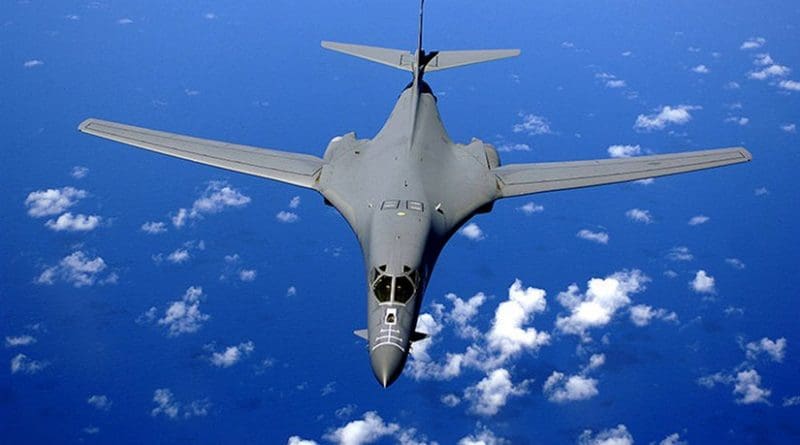Decoding The Air-Sea Battle Concept: Operational Consequences And Allied Concerns – Analysis
By RSIS
The emerging Air-Sea Battle (ASB) operational concept has been riddled with ambiguity and uncertain operational consequences. U.S. allies in East Asia have expressed varying perceptions and concerns, while the growing emphasis on the ASB has overshadowed conceptual alternatives and counterarguments within the U.S. military.
By Michael Raska
The AirSea Battle (ASB) concept does not specifically target China as an adversary, though it is predominantly focused on mitigating the strategic and military effectiveness of the PLA’s asymmetric military capabilities. These include long-range surveillance radar and precision missile systems, integrated air defense systems, anti-ship missiles, submarines, space and cyberwarfare capabilities. From the U.S. strategic viewpoint, these represent the so-called Anti-Access/Area-Denial (A2/AD) operational challenges, which may limit U.S. freedom of action in the Western Pacific.
In a hypothetical crisis scenario, in which China would use its increasingly sophisticated A2/AD capabilities, the ASB envisions U.S. military response in three distinct phases: (1) Blinding Campaign – striking PLA’s intelligence, surveillance, and reconnaissance (ISR) assets from afar in order to deny their situational awareness. In other words, by reducing the PLA’s ability to “see deep”, U.S. aircraft carrier groups would gain access to the battlespace; (2) Missile Suppression Campaign – disrupting PLA’s air-defense networks by stealthy long-range platforms, supported by submarine-launched weapons and sensors. By destroying or degrading Chinese critical air-defense assets and achieving air superiority, U.S. forces would be able to attack PLA’s land-based missile launchers, surface-to-surface missiles, and their supporting infrastructure; (3) Follow-On Operations – seizing the operational initiative by conducting diverse missions such as a “distant blockade” to ensure protracted U.S. freedom of action in the region.
Allied Perceptions: Reassurance or Abandonment?
Notwithstanding two semi-official reports published by the Center for Strategic and Budgetary Assessments (CSBA) and the recent Joint Staff publication entitled “Joint Operational Access Concept”(JOAC), the U.S. Department of Defense (DOD) has not articulated in detail to what purpose, end and degree the ASB concept is necessary.
Instead, the DOD has tried to convey the broader strategic rationale behind the ASB in the context of restoring and sustaining a stable military balance in the Western Pacific by strengthening deterrence vis-à-vis China, and providing U.S. Allies security assurances.
Assessing the ASB at the operational level, however, reveals that the concept does not explicitly focus on defending and relying on proximate U.S. Allied bases in East Asia. U.S. regional allies and partners are thus concerned whether the ASB provides strategic reassurance or abandonment. Moreover, the key question for U.S. allies is to what degree the ASB actually does assume active allied participation and contribution in the envisioned “deep strike-missions” on the Chinese mainland.
Conceptual Alternatives and Inter-Service Debates
Furthermore, with the prevailing emphasis on decoding the ASB in the media, think-tanks, and ultimately military services, there has been a lack of awareness of the existence of contending schools of thought and evolving alternative strategies and concepts that are shaping debates in the U.S military. Opponents of the ASB point to high escalatory dynamics and subsequent risks in the possible deep strikes on China. Implementing the ASB would also require substantial investment in new long-range stealth platforms, cutting-edge weapons technologies and capabilities, which the U.S. military may not afford.
Accordingly, there are conceptual alternatives to the ASB that propel internal debates in the U.S. military such as the Mutually Denied Battlespace Strategy currently emerging within the Naval Postgraduate School and the U.S. Naval War College. The “Mutual A2/AD Concept” refrains from initiating deep strikes on the Chinese mainland in order to gain access to the battlefield. Instead, it reverses the ASB concept by relying on the U.S. maritime-superiority to deny access for the Chinese warships in their waters and commercial shipping in the surrounding oceans. The office of Chief of Naval Operations is also considering an ASB-alternative that envisions using less stealth, but higher sortie rates from existing proximate Allied bases.
Policy Implications
Given its operational uncertainties, the ASB concept will be hotly debated, tested, and calibrated with continuously changing strategic realities and operational experiences of the U.S. forces. Its future course, however, will have significant policy implications, defense management ramifications, and operational consequences for U.S. allies in East Asia.
U.S. allies and partners in the Asia-Pacific such as South Korea, Japan, Australia and others have been relatively quiet on the implications of the ASB, largely because they do not share the full extent of planned operational details. In this context, what’s missing in the ASB debate is Allied participation. The operational uncertainty of the ASB may thus undermine future alliance credibility, and increase the incentives for allies to devise alternative defense strategies.
At the strategic level, the U.S. therefore needs to clarify the ASB concept in terms of its relevance to the new “rebalancing strategy” in the Asia-Pacific, while at the operational level, the U.S. military needs to articulate particular aspects of the ASB in terms of future Allied interoperability requirements and involvement. Perhaps most importantly, both the U.S. and China need to enhance their military-to-military cooperation in order to mitigate increasing strategic distrusts. It is only then that the ASB will not become a self-fulfilling prophecy.
Michael Raska is a Research Fellow at the Institute of Defence and Strategic Studies, a constituent unit of the S. Rajaratnam School of International Studies (RSIS), Nanyang Technological University in Singapore.

